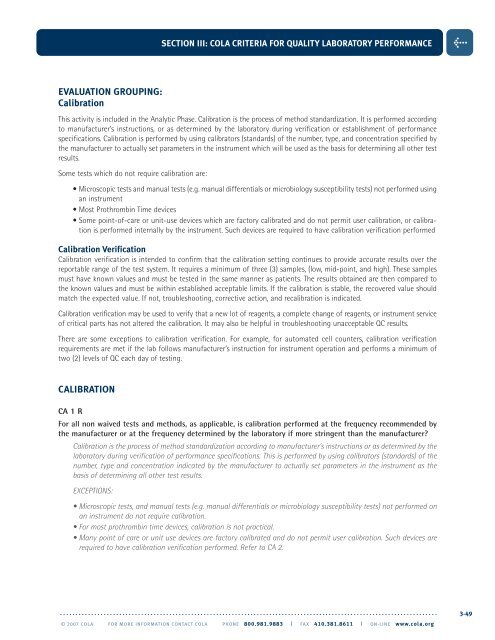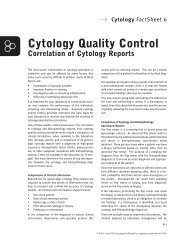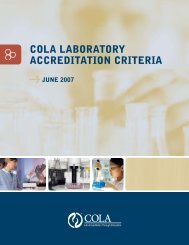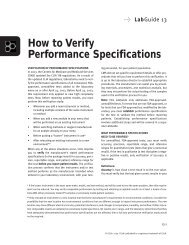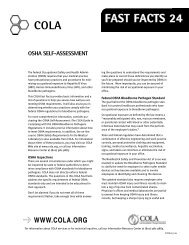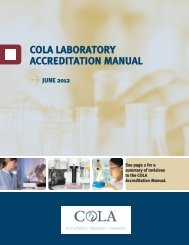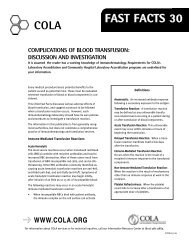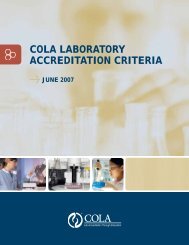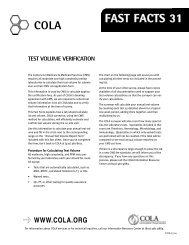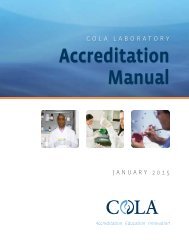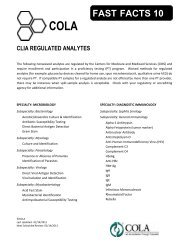Download - COLA
Download - COLA
Download - COLA
- No tags were found...
You also want an ePaper? Increase the reach of your titles
YUMPU automatically turns print PDFs into web optimized ePapers that Google loves.
SECTION III: <strong>COLA</strong> CRITERIA FOR QUALITY LABORATORY PERFORMANCE>EVALUATION GROUPING:CalibrationThis activity is included in the Analytic Phase. Calibration is the process of method standardization. It is performed accordingto manufacturer’s instructions, or as determined by the laboratory during verification or establishment of performancespecifications. Calibration is performed by using calibrators (standards) of the number, type, and concentration specified bythe manufacturer to actually set parameters in the instrument which will be used as the basis for determining all other testresults.Some tests which do not require calibration are:• Microscopic tests and manual tests (e.g. manual differentials or microbiology susceptibility tests) not performed usingan instrument• Most Prothrombin Time devices• Some point-of-care or unit-use devices which are factory calibrated and do not permit user calibration, or calibrationis performed internally by the instrument. Such devices are required to have calibration verification performedCalibration VerificationCalibration verification is intended to confirm that the calibration setting continues to provide accurate results over thereportable range of the test system. It requires a minimum of three (3) samples, (low, mid-point, and high). These samplesmust have known values and must be tested in the same manner as patients. The results obtained are then compared tothe known values and must be within established acceptable limits. If the calibration is stable, the recovered value shouldmatch the expected value. If not, troubleshooting, corrective action, and recalibration is indicated.Calibration verification may be used to verify that a new lot of reagents, a complete change of reagents, or instrument serviceof critical parts has not altered the calibration. It may also be helpful in troubleshooting unacceptable QC results.There are some exceptions to calibration verification. For example, for automated cell counters, calibration verificationrequirements are met if the lab follows manufacturer’s instruction for instrument operation and performs a minimum oftwo (2) levels of QC each day of testing.CALIBRATIONCA 1 RFor all non waived tests and methods, as applicable, is calibration performed at the frequency recommended bythe manufacturer or at the frequency determined by the laboratory if more stringent than the manufacturer?Calibration is the process of method standardization according to manufacturer’s instructions or as determined by thelaboratory during verification of performance specifications. This is performed by using calibrators (standards) of thenumber, type and concentration indicated by the manufacturer to actually set parameters in the instrument as thebasis of determining all other test results.EXCEPTIONS:• Microscopic tests, and manual tests (e.g. manual differentials or microbiology susceptibility tests) not performed onan instrument do not require calibration.• For most prothrombin time devices, calibration is not practical.• Many point of care or unit use devices are factory calibrated and do not permit user calibration. Such devices arerequired to have calibration verification performed. Refer to CA 2.. . . . . . . . . . . . . . . . . . . . . . . . . . . . . . . . . . . . . . . . . . . . . . . . . . . . . . . . . . . . . . . . . . . . . . . . . . . . . . . . . . . . . . . . . . . . . . . . . . . . . . . . . . . . . . . . . . . . . . . . .© 2007 <strong>COLA</strong> FOR MORE INFORMATION CONTACT <strong>COLA</strong> PHONE 800.981.9883 | FAX 410.381.8611 | ON-LINE www.cola.org3-49


